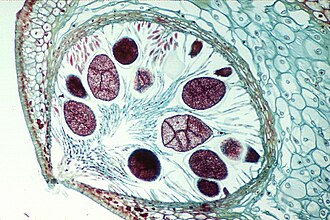Brown algae: Difference between revisions
CSV import |
CSV import |
||
| (One intermediate revision by the same user not shown) | |||
| Line 1: | Line 1: | ||
'' | {{Short description|A group of mostly marine, multicellular algae}} | ||
{{Taxobox | |||
| name = Brown algae | |||
| image = Laminaria_hyperborea.jpg | |||
| image_caption = ''Laminaria hyperborea'' | |||
| domain = Eukaryota | |||
| unranked_regnum = SAR | |||
| unranked_superphylum = [[Heterokonta]] | |||
| phylum = [[Ochrophyta]] | |||
| classis = [[Phaeophyceae]] | |||
}} | |||
'''Brown algae''' (class ''Phaeophyceae'') are a large group of mostly marine, multicellular algae, including many seaweeds located in colder waters within the Northern Hemisphere. They play a significant role in marine environments, both as food and for the habitats they form. | |||
Brown algae are | ==Characteristics== | ||
Brown algae are characterized by their brown or greenish-brown color, which results from the presence of the pigment [[fucoxanthin]], which masks the green of the [[chlorophyll]]. They are unique among algae in having this pigment, which is responsible for their distinctive color. | |||
[[File:Bladder_Wrack_(Fucus_vesiculosus)_-_geograph.org.uk_-_224125.jpg|thumb|right|''Bladder Wrack'' (''Fucus vesiculosus'')]] | |||
The | The cell walls of brown algae contain [[alginic acid]], a polysaccharide that is used commercially as a thickening agent in foods and other products. The thallus of brown algae is typically differentiated into a holdfast, stipe, and blade, although these structures can vary greatly in form and function. | ||
== | ==Reproduction== | ||
Brown algae exhibit a wide range of reproductive strategies, including both sexual and asexual reproduction. Many species have a complex life cycle involving alternation of generations, with both haploid and diploid stages. | |||
[[File:Laminaria_Life_Cycle.png|thumb|left|''Laminaria'' Life Cycle]] | |||
In the sexual reproduction of brown algae, gametes are produced in specialized structures called [[conceptacles]], which are found in some species such as ''Fucus''. The gametes are released into the water, where fertilization occurs. | |||
[[File:Fucus_conceptacle_XS3.jpg|thumb|right|''Fucus'' conceptacle]] | |||
== | ==Ecology== | ||
Brown algae are important components of marine ecosystems. They form dense underwater forests, known as [[kelp forests]], which provide habitat and food for a wide variety of marine organisms. These forests are among the most productive and dynamic ecosystems on Earth. | |||
[[File:Kelp-forest-Monterey.jpg|thumb|left|Kelp forest in Monterey]] | |||
==Economic Importance== | |||
Brown algae are harvested for their alginates, which are used in a variety of industries, including food, pharmaceuticals, and textiles. They are also used as fertilizers and soil conditioners. | |||
==Diversity== | |||
The class ''Phaeophyceae'' includes a wide variety of species, ranging from small filamentous forms to large kelps. Some well-known genera include ''[[Laminaria]]'', ''[[Fucus]]'', ''[[Sargassum]]'', and ''[[Macrocystis]]''. | |||
[[File:Saccharina_latissima_NOAA.jpg|thumb|right|''Saccharina latissima'']] | |||
==Related pages== | |||
* [[Algae]] | * [[Algae]] | ||
* [[Kelp]] | * [[Kelp]] | ||
* [[ | * [[Seaweed]] | ||
* [[ | * [[Marine biology]] | ||
[[Category:Brown algae]] | |||
[[Category:Ochrophyta]] | |||
[[Category:Algae]] | [[Category:Algae]] | ||
Latest revision as of 10:50, 23 March 2025
A group of mostly marine, multicellular algae
Brown algae (class Phaeophyceae) are a large group of mostly marine, multicellular algae, including many seaweeds located in colder waters within the Northern Hemisphere. They play a significant role in marine environments, both as food and for the habitats they form.
Characteristics[edit]
Brown algae are characterized by their brown or greenish-brown color, which results from the presence of the pigment fucoxanthin, which masks the green of the chlorophyll. They are unique among algae in having this pigment, which is responsible for their distinctive color.

The cell walls of brown algae contain alginic acid, a polysaccharide that is used commercially as a thickening agent in foods and other products. The thallus of brown algae is typically differentiated into a holdfast, stipe, and blade, although these structures can vary greatly in form and function.
Reproduction[edit]
Brown algae exhibit a wide range of reproductive strategies, including both sexual and asexual reproduction. Many species have a complex life cycle involving alternation of generations, with both haploid and diploid stages.

In the sexual reproduction of brown algae, gametes are produced in specialized structures called conceptacles, which are found in some species such as Fucus. The gametes are released into the water, where fertilization occurs.

Ecology[edit]
Brown algae are important components of marine ecosystems. They form dense underwater forests, known as kelp forests, which provide habitat and food for a wide variety of marine organisms. These forests are among the most productive and dynamic ecosystems on Earth.

Economic Importance[edit]
Brown algae are harvested for their alginates, which are used in a variety of industries, including food, pharmaceuticals, and textiles. They are also used as fertilizers and soil conditioners.
Diversity[edit]
The class Phaeophyceae includes a wide variety of species, ranging from small filamentous forms to large kelps. Some well-known genera include Laminaria, Fucus, Sargassum, and Macrocystis.
